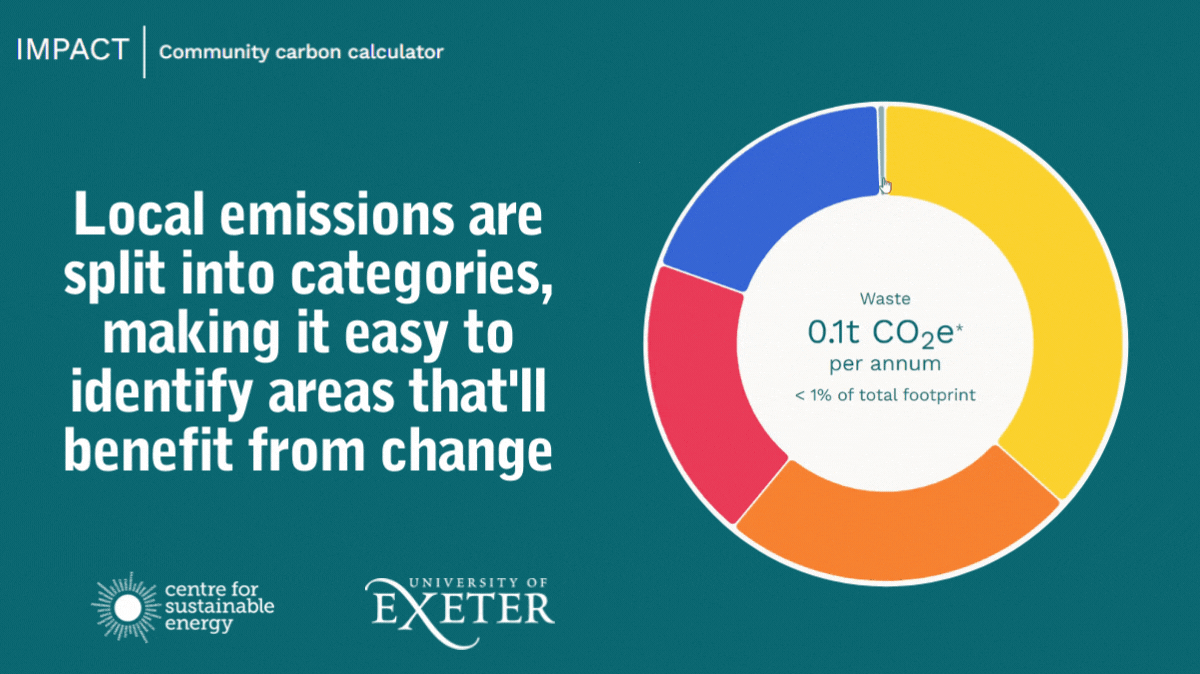
The Centre for Sustainable Energy (CSE), in collaboration with the University of Exeter, has developed the reach of the Impact Community Carbon Calculator, to cover the whole of England, Scotland and Wales. The innovative carbon foot printing tool also now offers data at ward level, in addition to parish and town council level. There’s a new automatic report generation function and changes to layout make data easier to understand and interpret.
‘Impact’ is a free, online tool providing small communities with easy-to-understand data about where most carbon emissions come from in their local area. It draws on more than 30 datasets to estimate the total greenhouse gases produced directly and indirectly from everyday human activities in a local area. This includes heating homes, using electricity, transport, producing and distributing food, disposing of waste and more.
People and communities can use this information to work together and agree the best, most impactful activities to cut emissions in their local area. So far, the Impact Community Carbon Calculator has supported thousands of people and around 300 local councils.
Speaking about the developments to Impact, Annette Lamley of CSE said: “Impact supports local climate emergency plans, through identifying the best climate actions at community level. To reach our net zero targets, we all need to adjust our priorities, make different choices in what we buy, change our habits and practices, and organise and work with others in new ways.
“Impact helps drive this change through supporting people and groups in local communities to understand their local emissions. This means that local climate actions focus on the big-emissions sectors rather than spending time on well-meaning but low-impact activities.”
Impact uses two different but complementary approaches to carbon footprinting: territorial-based reporting and consumption-based reporting*. Both approaches can provide useful information to help target local action.
Dr. Dan Lash of the University of Exeter commented: “Whilst there are already plenty of good options for individuals looking to understand their own carbon footprint, we know there has been a lack of data to help communities work together at a local level. We hope that what we have developed with CSE will be a helpful addition so that local communities can develop common solutions.”
Michael Gallagher, Head of Midlands Energy Hub said: “The Midlands Energy Hub knows, as a result of the number of communities using the first Iteration of the Impact tool, that it provides a valuable resource to help users understand local carbon footprints. It has been fantastic for the Midlands Energy Hub to support the second phase of development, which will enable even more communities to decide how they can tackle their own net zero challenges, enabling a place-based, community-led approach in supporting the local transition to net zero.”
Alongside the Impact tool, CSE also supports community groups to implement actions through its Climate Emergency programme and signposts groups to local organisations that are well placed to support their specific initiatives.
There are a selection of stories about how local councils and community groups have used the Impact Community Carbon Calculator here.
Speaking about the Impact Community Carbon Calculator, Shelaine Siepel, Managing Director – Sustainable Business Partnership CIC commented: “Thank you for developing this amazing Impact tool and making it open access with no requirement to buy further services (which is something I am coming across a lot with anything carbon footprint related). Working with Lewes District Council as part of the District’s Climate Action Forum, we used the tool to compare carbon footprints of eight parish and town councils to help focus activities on the areas of highest impact. It has been fascinating to go through the data comparatively for the different areas as we have great variety in socio-economic factors in this district.”
The updates to the Impact tool have been supported through BEIS, Midlands Energy Hub, Kenneth Miller Trust, Newby Trust and Gower Street foundation.
You can support the Impact Community Carbon Calculator through our Crowdfunder here.
*A territorial footprint looks at all emissions that arise from activities within a particular boundary, covering for example road and rail travel, industrial and commercial emissions and agriculture, and household energy use. The consumption footprint also looks at household energy use, but it differs from the territorial approach in that it considers the behaviours and the purchases of the people living in that area, including goods and services, much of which are imported from outside – like food, clothing, banking and medical services.








